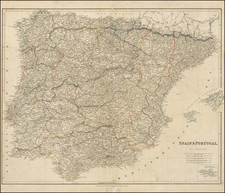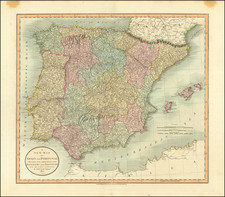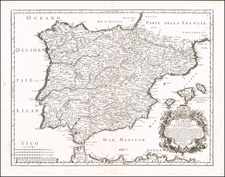The map provides a detailed representation of a portion of the western part of the Castile region in Spain, focusing specifically on the provinces of Madrid, Toledo and Mancha.
In the 18th century, Madrid, depicted prominently on the map, was in the midst of a transformation. As the capital of Spain since the late 16th century, Madrid became an epicenter of arts, politics, and commerce. The map shows the Manzanares River, a notable geographical feature flowing through the region.
To the southwest of Madrid lies Toledo, an ancient city that stands atop a hill, along the Tagus River Known as the "City of Three Cultures," Toledo was a melting pot of Christian, Jewish, and Muslim influences. By the 18th century, while its political significance had waned with the shift of the capital to Madrid, its historical and religious importance remained undiminished.
The vast expanse of La Mancha, stretching to the south, is perhaps best known to the world through literature—as the backdrop of Miguel de Cervantes' "Don Quixote." This plateau region is characterized by its windmills, vast plains, and vineyards. The Guadiana River, one of the Iberian Peninsula's major rivers, winds its way through this region.
Apart from the cities and the geographical markers, the map features the road networks, trade routes, and other smaller settlements that dotted these provinces. Based on the work of Tomás López, a notable Spanish cartographer of the 18th century, the map is detailed and artistically rendered.
Homann Heirs was a German publishing firm that enjoyed a major place in the European map market throughout the eighteenth century. Founded in 1702 by Johann Baptist Homann, the business passed to his son, Christoph, upon Johann’s death in 1724. Christoph died in 1730, aged only 27, and the firm was inherited by subsequent Homann heirs. This altered the name of the company, which was known as Homann Erben, or Homann heirs. The firm continued in business until 1848.
Tomás López de Vargas Machuca (1730-1802) was one of Spain’s most prominent cartographers in the eighteenth century. He was born in Toledo but studied at the Colegio Imperial in Madrid, where he focused on mathematics, grammar, and rhetoric. Along with a small group of colleagues, in 1752 the Spanish government sent López for training in Paris with the renowned geographer Jean Baptiste Bourguignon d’Anville. When he returned to Spain he was named Geógrafo de los dominios de Su Magestad and put in charge of the geographic collections of Charles III. He published many maps, including his fascinating maps of the Americas, and a variety of geography manuals. Some of his most famous maps are of the Iberian Peninsula, part of his large project to create a majestic atlas of Spain. Unfinished in his lifetime, López's children published the Atlas Geográfico de España (Geographical Atlas of Spain) in 1804. It was republished in 1810 and 1830.










![[Alhambra / Granada ] Alhama](https://storage.googleapis.com/raremaps/img/small/77312.jpg)



![[Gipuzkoa / Bay of Cadiz / Toledo - Tagus River ] Hanc Insulam Perlustrabat . . . [with] Carpetaniae . . . 1584 [with] Guipuscoae Regionis Typus. . .](https://storage.googleapis.com/raremaps/img/small/78971.jpg)